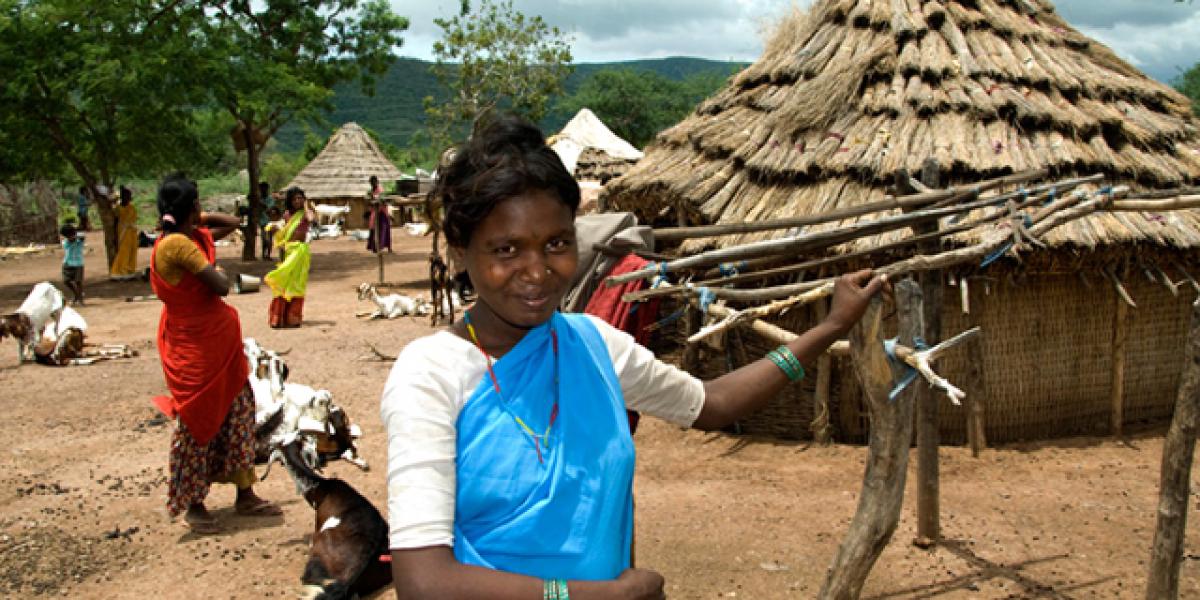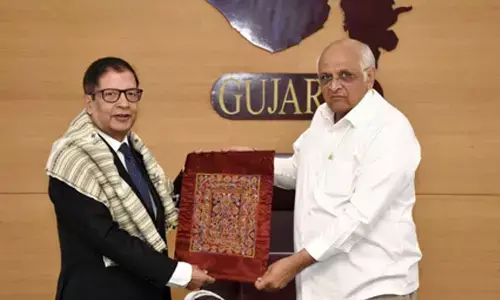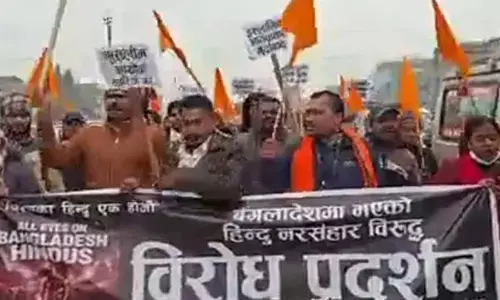Tribal development a myth

Tribal development a myth. The State government of Andhra Pradesh observed the World Indigenous People’s day on 9th August with stage-managed meetings without coming up an adequate action plan to address the critical issues of adivasis.
During the current financial year, Rs 1,904 crore was earmarked for the Tribal Sub Plan (TSP) in AP, while the budget releasing orders by State Finance Department were only for Rs 605.77 crore, which is 31.81 per cent of the total TSP allocation. Further depressing is the actual expenditure for tribal development, being Rs 496.27 crore, which is 26.05 per cent of the total TSP budget provision. Some of the departments like Fisheries, Forests, Intermediate Education, Tourism, etc, reported nil expenditure so far. In many such land issues, the non-tribals are in occupation of the Scheduled Area lands by virtue of stay orders obtained from various courts, and the poor tribals are not in a position to expedite the issues relating to vacation of stay or disposal of the cases through the government machinery
The State government of Andhra Pradesh observed the World Indigenous People’s day on 9th August with stage-managed meetings without coming up an adequate action plan to address the critical issues of adivasis. The Particularly Vulnerable Tribal Groups (PVTG) are largely dependent on shifting cultivation and collection of minor forest produce from the forests in the State of Andhra Pradesh.
.jpg)
Edible roots, tubers, leafy vegetables, Mahua flower are used to satiate the hunger pangs of tribals who are unable to have a square meal a day. Supply of subsidised rice of 35 kg to PVTGs by the government is not adequate to meet the required quantity of food for the family.
The total tribal population is 27.39 lakh, which constitutes 5.53 per cent of the total State population in Andhra Pradesh. The State is a traditional habitat for 19 tribal communities. Among them Chenchu, Kondareddy, Kondh, Porja, Gadaba, and Savara are specially categorised as Particularly Vulnerable Tribals Groups (PVTG).
The habitats of these vulnerable tribes are located on the hill tops and slopes where plain landscape is absent. The percentage of PVTG population is 16.5 of the total ST population in the State. The literacy rate in Kondhs is 29.72 which is lower than that of other PVTGs in the State. This is followed by34.99% for Porjas and 49.74% for Savara, which is recorded as highest among the PVTGs as per the 2011 census.
It is sad that a small population of the most vulnerable tribes remains poor, illiterate, and malnourished even after forty years of tribal development programmes in the State. Tribal welfare action plans lacked special attention to reduce vulnerability of the PVTGs in particular and meaningful approach to tribal welfare in general.
Since the tribal welfare programmes failed to strengthen the coping abilities and resilience of the tribal groups, some of the PVTGs like Savaras in Srikakulam district, Gadabas in Vijayanagaram district, Konda Reddys in East Godavari District are migrating to other districts and States in search of wage employment. Though most of the tribes are engaged in some subsidiary economic pursuits, the dominant mode of tribal economy still remains podu, and food gathering.
Agriculture is mainly traditional in nature and primarily rain fed. The notion of surplus is conspicuously absent in their economies. Tribals are marginalised due to shrinking of their traditional survival resource base of land and forests due to intervention of State mining, irrigation projects on one hand and infiltration of non tribals to grab the tribal land on the other.
An enquiry into their food security issue of Konda Reddys in Addarivalasa in Maredumilli mandal in East Godavari district, Savaras in Killada and Titukupaiguda villages in Seethampeta mandal in Srikakulam district, Gadabas in Reyyavanivalasa, PasupuvaniValasa, Dattevalasa, Gadidakarapavalasa in Salur mandal in Vizianagaram districts highlights the plight of tribals.
Studies on consumption and income arising from assets and work participation indicates severe gaps, a shortfall of foodgrains as well as financial need in every family to tide over the crisis. A field visit in these villages reveals that tribal families have loans from Rs 6,000 to 15,000.
Both income and poverty risk is running across the families. A majority of Savaras and Gadaba households are more vulnerable to the rapacious money lenders who collect exorbitant rates of interests. Money lenders charge 3 to 5 per cent per month! The Tribal Sub Plan (TSP) was formulated primarily to protect the tribes from exploitation by outsiders and to improve their socio-economic opportunities.
The erstwhile Andhra Pradesh government also brought the SC and ST Sub Plan Act 2013, the first of its kind in the history of the country, aiming at ensuring accelerated development of SC&STs by earmarking a portion of the total State Plan outlay, in proportion to the population of SCs and STs in the State. However, the implementation of the law is tardy and not fully yielding desired objectives.
During the current financial year, Rs 1,904 crore was earmarked for the TSP, while the budget releasing orders by State Finance Department were only for Rs 605.77 crore, which is 31.81 per cent of the total TSP allocation. Further depressing is the actual expenditure for tribal development, being Rs 496.27 crore, which is 26.05 per cent of the total TSP budget provision.
Some of the departments like Fisheries, Forests, Intermediate Education, Tourism, etc, reported nil expenditure so far. Some of the departments like Society of Elimination of Rural Poverty (SERP), Panchayat Raj (RGPSA), Skill Development etc are yet to give action plans for implementation of the Tribal Sub Plan Act.
It is also disheartening to note that the NDA partner and ruling TDP in Andhra Pradesh has failed to get the approved tribal welfare budget of Rs 30 crore for the year 2014-2015 from the Central government and Rs 40 crore for the current financial year 2015-16 which is intended for the advancement of tribals.
The implementation of Land Transfer Regulations 1 of 70 is the touchstone for the performance of the State government. Regulations prohibit transfer of lands between tribals and non-tribals as well as among the non-tribals in the Schedule Area.
A total of 1,615 cases are pending at various courts covering an extent of 10,404 acres. A total of 27,653 cases were disposed of covering an extent of 1,42,020 acres. Tribals could succeed in 45 per cent of the total cases disposed of covering an extent of 55,781 acres, and the rest were decided in favor of non tribals.
Almost 50 per cent of the total sanctioned strength to implement LTR (land transfer regulation) at ITDA level is lying vacant in the State. While studying the issue relating to atrocities against tribals, the Justice K Punnayya Commission in 2001 observed that there are a large number of disputes pending in various courts relating to the land in the Scheduled Areas of the State.
In many such land issues, the non-tribals are in occupation of the Scheduled Area lands by virtue of stay orders obtained from various courts, and the poor tribals are not in a position to expedite the issues relating to vacation of stay or disposal of the cases through the government machinery.
The poor outcome of implementation of Forest Rights Recognition Act 2006 is also an indication of non-recognition of tribal forest rights in Andhra Pradesh. The total forest individual claims numbering 1,50,488 were submitted covering an extent of 3,20,539 acres.
The total forest land titles (83,493) covering a land of 4,97,767 acres were only distributed, which amounts to 55 per cent of the total claims received. A path-making legilslation, the Panchayat (Extension to Scheduled Areas) Act (PESA 1996), was brought, ushering in sweeping changes in the rules to empower Gram Sabhas in the Scheduled Areas of country over land, forest and other assets.
Rules were also made by the AP government, making it compulsory to get the Gram Sabha’s consent for approval of socio, economic schemes, grant of licence to open a liquor shop or mining for minor minerals etc. in the Scheduled Areas. However, the State and its authorities have systematically failed to make the PESA operational.
In the light of these facts, can the governments pay attention to these weakest sections of the society and bring change in their life situation along with claims of turning the Andhra Pradesh into Singapore? It is time we asked how long a small population of the tribals in our State should remain poor and get exploited. (The writer, an advocate and a researcher, can be contacted at [email protected])
By Dr Palla Trinadha Rao

















